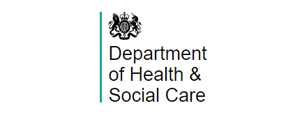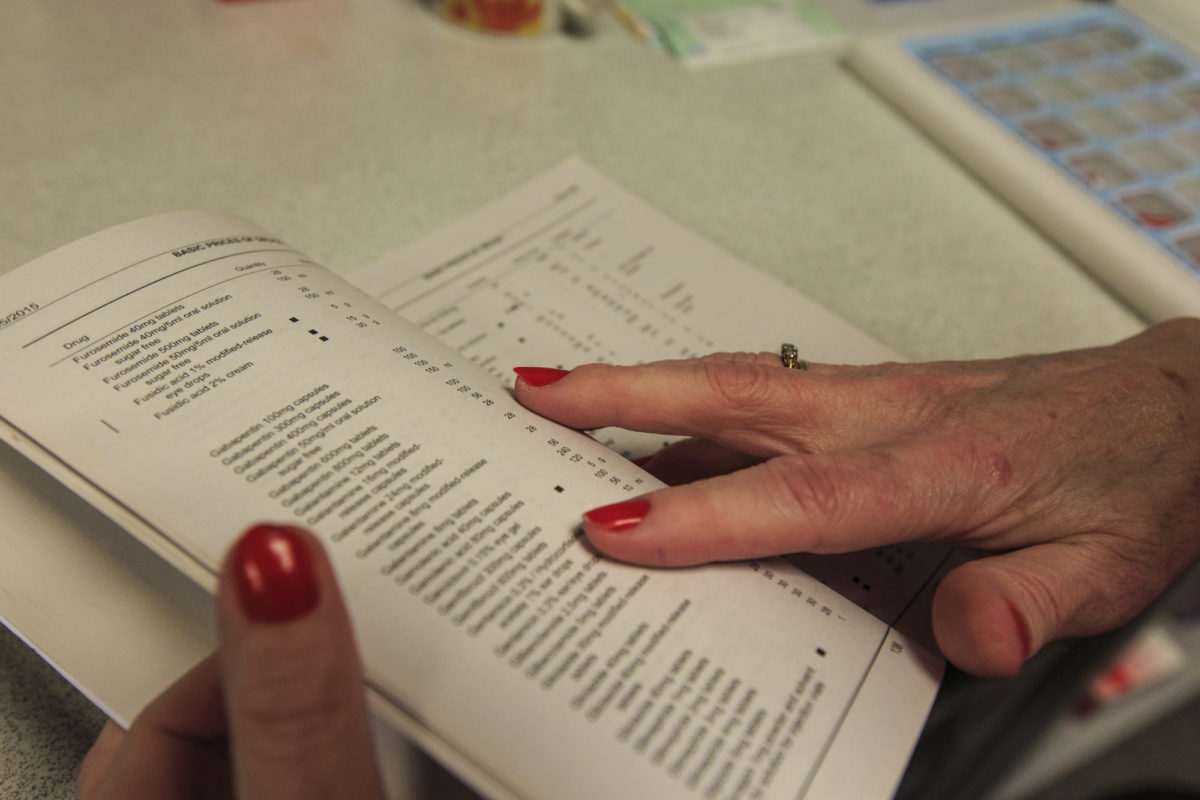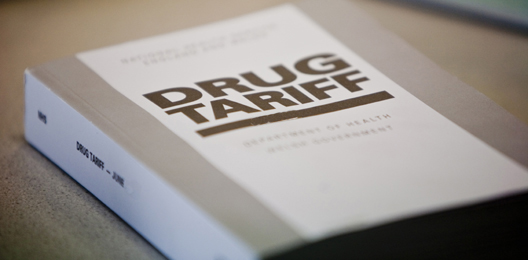Prescription form validity
Published on: 17th July 2013 | Updated on: 9th April 2024
Only certain types of paper prescription forms can be used for dispensing within the NHS and with varying lengths of legal validity. It is therefore important for community pharmacy teams to be able to identify which paper form types are valid and allowed, and which are not. And also to be aware of the length of legal validity for supply of medicine against different types of NHS prescriptions.
Paper form types can be identified by the code on the bottom right of a prescription. EPS prescriptions include prescriber type EPS codes that indicate the type of prescriber e.g. a General Practitioner (GP) or a Community practitioner nurse. Read more at EPS prescriber type code.
The table below indicates the prescriptions forms that can be used for dispensing by NHS community pharmacy teams in England and Wales.
Forms originating in England
| Colour of paper form | Paper form | Who they are used by | Further information |
| Green | FP10SS |
|
Prescriptions must be annotated with the type of prescriber issuing it, for example, community practitioner nurse prescriber (formerly known as district nurse/health visitors) or nurse independent prescriber. Forms annotated with the initials RD are repeat dispensing forms. Forms annotated with the initials RA are repeat authorisation forms. Further information can be found on our Who can prescribe what? page. |
| FP10NC |
|
||
| FP10HNC |
|
||
| Blue | FP10MDA-SS |
|
Prescriptions must be annotated with the type of prescriber issuing it. Further information can be found on our pages Who can prescribe what? and Instalment Dispensing. |
| FP10MDA-S |
|
||
| FP10MDA-SP |
|
||
| FP10HMDA |
|
||
| Yellow | FP10D |
|
Only items listed in the Dental Formulary (Part XVIIA of the Drug Tariff) can be prescribed on this prescription form. Dentists are strongly advised to prescribe generically; however, they can prescribe by its brand equivalent name provided it is not listed in Part XVIIIA of the Drug Tariff (drugs, medicines and other substances that may not be ordered under the NHS). Further information can be found on our Who can prescribe what? page. |
| Lilac | FP10PN |
|
Prescriptions must be annotated with the type of prescriber issuing it. Unless annotated with Independent/Supplementary prescriber, only items listed in the nurse formulary can be prescribed on this prescription. Further information can be found on our Who can prescribe what? page. FP10P-REC are used by OOH providers to record items supplied directly to a patient and not dispensed through a community pharmacy. These forms, are submitted to Pricing Authority directly by the OOH provider through their own account. |
| FP10SP |
|
||
| FP10P-REC (Non-FP10 supply form) | Out of Hours (OOH) Centre prescribers | ||
| White online | FP10CDF | Controlled Drug requisition form |
The buff coloured FP10CDF Controlled Drug requisition form to obtain Schedule 2 and 3 Controlled Drugs for stock from a community pharmacy has been replaced with a new approved mandatory requisition form which is available from the NHSBSA website. Requisitions must be received on the new mandatory form. Further information can be found on our Controlled Drug prescription forms and validity and Who can prescribe what? pages. |
| Pink | FP10PCDSS | Prescribers of Schedule 2 and 3 controlled drugs prescribed in the private sector where prescriptions are dispensed by community pharmacy |
Prescriptions must be annotated with the type of prescriber issuing it. Copies need to be sent to the Pricing Authority separately to NHS prescription forms at the end of the month for audit purposes. You will need a private dispensing code, which is separate to your normal OCS code, when you fill in the FP34PCD under A/C ID. Further information can be found on our Controlled Drug prescription forms and validity and Who can prescribe what? pages. |
| FP10PCDNC |
These forms are used by prescribers to print paper prescriptions or EPS tokens.
Length of legal validity
The table below applies to supply against paper and electronic prescriptions.
| Type of prescription | 1st issue – end of validity for real-life dispensing * |
Subsequent issues validity period (if any) for real-life dispensing |
| All types of FP10 prescriptions for all medicinal products including Schedule 5 Controlled Drugs (CDs) (excluding requests for Schedule 1, 2, 3 or 4 CDs) | 6 months | 12 months for repeatable prescriptions from the signed date. |
| FP10 for Schedule 1, 2 or 3 CDs | 28 days | N/A (cannot be on repeatable prescriptions) |
| FP10 for Schedule 4 CDs | 28 days | 12 months for repeatable prescriptions from the signed date. |
| FP10MDA prescriptions | 28 days | In accordance with instalment directions. A prescriber can request up to 14 days’ supply. |
*from the ‘appropriate date’ (either the date the prescription was signed or a date indicated by the prescriber as the date before which the drug cannot be supplied). See Controlled Drug prescription forms and validity.
Pharmacy teams should also be aware of the timing of sending EPS prescription messages and the EPS claim reconciliation period. The national EPS system will prevent dispense messages being sent for those EPS prescriptions older than six months. In addition, EPS claim notifications must be sent within 180 days (six months) of the final dispense message, and may not be priced after this time. The NHS Digital dispensing system specification explains EPS 180-day time limits are to ensure that the size of the prescription database on the Spine remains manageable. For information on EPS timings see here. EPS and CDs: EPS dispense/claim messages will be sent from time to time after the supply of medicine (e.g. because of technical or internet outage) and therefore there is no need for system suppliers to put up barriers interrupting reimbursement. Your system supplier may be able to assist in future (if it does not already) with the prevention of medicine being actually supplied after the end of validity period (table above) e.g. by providing warnings when relevant dates will/have pass(ed) without blocking appropriate reimbursement being possible.
Additional information
| Paper form | Who can use or what they are used for | Further information |
| WP10 WP10SS WP10SP WP10HP WP10HSP |
|
Forms annotated with the initials RD are repeat dispensing forms. Forms annotated with the initials RA are repeat authorisation forms. |
| WP10D |
|
Only items listed in the dental formulary can be prescribed on this prescription. |
| WP10CN WP10PN |
|
Only items listed in the relevant formularies can be prescribed on this prescription. |
| WP10MDA WP10HP(AD) |
Instalment dispensing prescription form | More information on can be found on our Instalment Dispensing page. |
| Paper form | Who can use or what they are used for |
| GP10 |
|
| GP10(N) |
|
| GP10(P) |
|
| GP10(OP) |
|
| GP10(NMP) |
|
| GP10(A) | For doctors ordering stock order supplies from a pharmacy |
| GP14 |
|
| CDRF | Controlled drug requisition forms are for prescribers ordering a stock of controlled drugs |
| PPCD forms | For private prescribers who write prescriptions for controlled drugs |
| HBP |
|
| HBP(A) |
|
| Paper form | Who can use or what they are used for |
| HS21 HS21CS |
|
| HS21D |
|
| HS21X HS21XCS |
Non-Medical Prescribers
|
| HS21N HS21NCS |
|
Please note – Instalment dispensing has no specific form type in Northern Ireland and can occur on HS21, HS21N, HS21X, SP1 & SP2 forms (SP1 & SP2 forms are used by Consultants in secondary care to provide substitute prescribing drugs in primary care, it would be unlikely for these forms to be presented to a pharmacy outside of Northern Ireland).
| Paper form | Who can use or what they are used for |
| HS10 |
|
| HS10MDA | Instalment dispensing form. |
| HS10SS |
|
Pharmacy contractors in England and Wales WILL NOT be reimbursed by the NHS for dispensing the following prescription forms:
| Paper form | Reason for not dispensing |
| CP2/3 | Generated as part of the Scottish Minor Ailment Service. |
| CPUS | Community pharmacy urgent supply forms generated by Scottish pharmacies. |
| FMed296 | Issued to service personnel (army). Should be dispensed in a barracks pharmacy. |
| FP10CDF/WP10DF | Controlled Drug requisition form. |
| FP10L | Drug testing scheme form. |
| FP10PRec | Used by out of hours centres. |
| GP10A | Scottish GP stock order form. |
| GP10S | Issued to Scottish service personnel. |
| GP10DTS | Drug testing scheme in Scotland. |
| HOOF | Used to order home oxygen from the NHS home oxygen service suppliers. |
| HS21S | GP stock order form in Northern Ireland. |
| PS6 | Issued by primary care prescribers in Guernsey. |
| H9 | Issued by primary care prescribers in Jersey. |
| FP10PCD-SS FP10PCD-NC |
English private prescription for Controlled Drugs. Copies of these forms should be sent to the Pricing Authority each month for information purposes and not for reimbursement. More information is available in the Controlled Drug Guidance section of this site. |
| WP10PCD WP10PCDSS |
Welsh private prescription for Controlled Drugs. Copies of these forms should be sent to the Pricing Authority each month for information purposes and not for reimbursement. More information is available in the Controlled Drug Guidance section of this site. |
| PPCD(1) | Scottish private prescription for Controlled Drugs. Copies of these forms should be sent to the Pricing Authority each month for information purposes and not for reimbursement. More information is available in the Controlled Drug Guidance section of this site. |
Please refer to the prescription charges section of our website for guidance on whether forms originating elsewhere in the UK attract prescription charges or not.
A regulatory package, the National Health Service (Amendments Relating to Pre-Payment Certificates, Hormone Replacement Therapy Treatments and Medicines Shortages) Regulations 2023, supports the introduction of the HRT PPC and was laid before Parliament on the 21 February 2023 coming into force on 1 April 2023. The package seeks to avoid such mixed prescriptions as follows:
- First, mandating single item prescribing for Drug Tariff listed HRT medicines, so that one listed HRT medicine is prescribed on one prescription, and other non-HRT items are prescribed on separate prescriptions, and
- Second, allowing contractors to refuse to dispense ‘mixed’ prescriptions – prescriptions for patients with an HRT PPC that contain both a listed HRT medicine and a non-HRT item – as well as allowing other options.
The change to the NHS (Pharmaceutical and Local Pharmaceutical Services) Regulations 2013 allowing contractors to refuse to dispense a mixed prescription to a patient with an HRT PPC gives 3 options. Contractors may either:
- First, refuse to dispense a ‘mixed’ prescription presented by a patient – refuse to dispense both the listed HRT medicine and the other non-HRT item – and ask the patient to return to the GP for two separate prescriptions, or
- Second, either:
– dispense the listed HRT medicine (the patient or the patient’s representative signing to claim the HRT PPC exemption), or
– dispense the other non-HRT item(s) with the prescription charge(s) paid, or
(This may be appropriate if the patient has an urgent clinical need for the listed HRT medicine or non-HRT item(s); the patient will need to obtain another prescription for any items not dispensed) - Third, dispense both the listed HRT medicine and the non-HRT item(s) – and complete an FP57 refund form for the listed HRT medicine (there is a charge and refund for the HRT medicines, so no money changes hands – (see note below) and take a prescription charge for the non-HRT item(s).
The Department of Health and Social Care is advising pharmacies to refuse to dispense ‘mixed’ prescriptions to patients with an HRT PPC, unless the patient needs one or more of the prescription items urgently. This may be appropriate for pharmacy contractors due to the financial risks with processing ‘mixed’ prescriptions for patients with an HRT PPC.
Note: If the patient is in possession of a valid HRT PPC at the time of dispensing, then only charges for the non-HRT items should be collected and the FP57 form should be completed at the same time for the HRT medicines. This will avoid the need for the pharmacy to collect and refund charges for any HRT medicines supplied at the same dispensing episode. As the prescription is marked as ‘Paid’, the NHSBSA will deduct charges for all items (HRT and non-HRT) on the prescription and the pharmacy can re-claim the charges for the HRT medicines dispensed by declaring the number of FP57 forms submitted and total value of charges to reclaim via the end of month FP34C submission form on MYS.
For more information see our Community Pharmacy England Briefing 008/23: FAQs to support DHSC guidance on the new HRT prescription prepayment certificate (HRT PPC).
For prescriptions requesting Schedule 1, 2, 3 or 4 CDs, owings cannot be dispensed later than 28 days after the appropriate date on the prescription. It is good practice for the pharmacist to make the patient or their representative aware at the outset that they will not be able to collect the balance after the 28 day period has elapsed.
The owing balance of prescriptions for prescriptions for Schedule 5 CDs and other medicines that are not CDs cannot be collected more than 6 months after the appropriate date. The exception is for owings for repeatable prescriptions (which have a maximum validity of 12 months from the prescriber’s date).
Also, it is important to note that owings are not appropriate for CDs which are being supplied in instalments, as the quantity of the instalment dispensed must be exactly as specified on the prescription. Any missed instalments can only be given on the following day if the prescriber has specified this is permissible – the Home Office has approved specific wording to be used that gives pharmacists a degree of flexibility when making a supply There is wording which allows a pharmacy to supply the balance of an instalment if the interval date is missed (e.g. if three days’ supply was directed to be supplied on day 1 but it was missed, it could allow two days’ supply to be issued on day 2).
The National Health Service (General Medical Services Contracts) Regulations state that ‘prescription forms’ and ‘repeatable prescriptions’ must be in the format required by the NHS Business Services Authority (NHSBSA).
These overprinting requirements specify the format required by the NHSBSA for all prescriber types printing FP10SS prescription forms.
The scope of the specification includes:
- GP practices ‘parented’ by a Clinical Commissioning Group
- Repeat Dispensing – a repeatable prescription form authorises a number of batch issue prescription forms which are to be produced at the same time.
- Prescription forms dispensed by a Community Pharmacy, by an Internet Pharmacy, by an Appliance Contractor or by a Dispensing Doctor.
For the full specification click here.
A separate prescription form should be issued for each individual patient; the only exception to this is ‘bulk prescriptions’.
Part VIIIA, Notes, Paragraph 9 of the Drug Tariff outlines the arrangements for bulk prescriptions:
A “Bulk” prescription is an order for two or more patients, bearing the name of a school or institution in which at least 20 persons normally reside, for the treatment of at least 10 of whom a particular doctor is responsible. Such a prescription must be an order for a drug which is prescribable under the NHS and which is not designated “Prescription Only Medicine” (POM) under Section 58(1) of the Medicines Act 1968, or for a prescribable dressing which does not contain a product which is designated POM.
No prescription charge is payable when a bulk prescription is dispensed.
The Pricing Authority, when it prices prescriptions, must be able to identify the cost centre in order to recharge the costs to the appropriate area. Part II clause 6 of the Drug Tariff provides the following information relating to the identification of the prescriber.
‘Where a contractor provides the drugs or appliances ordered on any NHS prescription form, except forms issued by a Dental Practitioner, the Pricing Authority may return the prescription form to the contractor (as a referred back) if there is no prescriber code(s) present on the prescription form and request that the contractor seek the appropriate code(s).
Where the contractor is able to identify the appropriate code(s), they shall endorse the prescription with the code and return it to the Pricing Authority. Where the contractor is unable to identify the appropriate code(s), they shall endorse the prescription to indicate that they have been unable to locate the code and return it to the Pricing Authority to be paid. Returned prescriptions shall be priced using the Drug Tariff relevant to the month in which the prescription is returned to the Pricing Authority.’
Pharmacy team requirements
It is really important that pharmacy teams check prescriptions for prescriber cost centre codes at the time of dispensing and attempt to identify and insert codes where any are missing as prescriptions missing the prescriber cost centre code (except dental prescriptions) may be returned to the contractor by the Pricing Authority as a referred back form. This could lead to a delay in payment for that prescription.
Pharmacy staff are not expected to validate prescriber codes, they are only expected to ensure that the code is present. The Pricing Authority validates these codes; prescriptions with incorrect codes will still be paid and will not be returned to the pharmacy.
For more information see Prescriber cost centre codes.
Q. There has been an outbreak of scabies within a family. Rather than issuing one prescription per family member, the prescriber has ordered sufficient quantity of Permethrin 5% cream on one prescription to cover the whole family. Is this allowed?
No. Bulk prescription are not intended to cover situations such as these. The only exception to this rule is where the prescriber is responsible under their GMS contract for the treatment of 10 or more persons in a school or other institution in which at least 20 persons normally reside; and where the prescriber needs to prescribe for two or more of those persons for whose treatment the contractor is responsible. The prescription should bear the name of the school of institution concerned.
More information about bulk prescriptions can be found in Part VIIIA, Notes, Paragraph 9 of the Drug Tariff. A key point to note is that bulk prescriptions can only be issued for prescribable dressings and for medicines which are not classified as prescription only medicines.
Q. Is it legal for a GP to post-date prescriptions, say for 3 or 6 months, for a patient to retain and get dispensed when required?
Yes. According to The Human Medicines Regulations 2012, a prescription must be endorsed with an “appropriate date”, defined as “…the later of the date on which it was signed by the appropriate practitioner giving it or a date indicated by the appropriate practitioner as being the date before which it should not be dispensed (see Reg. 217 (7)).”
However, we suggest that the GP should give serious consideration to whether a repeatable prescription will be more appropriate, especially for those medicinal products which are suitable for repeat prescribing – repeatable prescriptions enable the pharmacist to make checks on whether the continued medication is appropriate for the patient, and are generally a preferred method than post-dating prescriptions.
Q. What key changes have been made to the Pharmaceutical and Local Pharmaceutical Services (PLPS) Regulations and related regulations following the introduction of the HRT PPC?
The PLPS Regulations have been amended so that dispensing contractors will be able to, but not be required to, refuse to supply items on a ‘mixed’ prescription where a charge exemption is being claimed based on the HRT PPC and a charge must be paid for the non-HRT item(s).
Regulations related to GPs have been amended to mandate that a listed HRT medicine must be prescribed on a separate NHS prescription to other items – that a prescriber must only order one prescription item on a prescription form or repeatable prescription that is used by the prescriber for ordering a listed HRT medicine.
Q. What are the issues with ‘mixed’ HRT prescriptions and why do prescribers need to issue separate prescriptions for listed HRT medicines?
NHSBSA and Patient Medical Record (PMR) systems are not designed to handle ‘mixed’ prescriptions, they are designed to handle paid (the patient pays a prescription charge) or (and this includes prescriptions subject to a PCC) exempt prescriptions. Free-of-charge items (contraceptives and STI treatment) are handled by zero-rating the medicines or prescriber endorsement and can be processed on paid prescriptions.
In some instances, a pharmacist may part-dispense or fully-dispense a ‘mixed’ prescription because a patient has an urgent need for either the HRT medicines or the non-HRT items, or both. If part-dispensed, the patient will then need to ask the prescriber to prescribe the item that was not dispensed on the ‘mixed’ prescription. If none of the items on a ‘mixed’ prescription are dispensed, the patient will need to ask the prescriber to issue separate prescriptions for HRT medicines and non-HRT items.
Risks for contractors dispensing or part dispensing ‘mixed’ prescriptions to a patient with an HRT PPC include deductions of a prescription charges from their remuneration where no charge was collected (which results in a financial loss to the pharmacy), or claiming an item as exempt where a prescription charge was collected (which results in an overpayment to the pharmacy and the additional work of dealing with NHS recovery of the overpayment, and the potential for serious allegations against the pharmacy).
Q. Am I in breach of the NHS Pharmacy Terms of Service if I refuse to dispense a ‘mixed’ prescription that contains a listed HRT medicine and other chargeable items to a patient with an HRT PPC?
No. This is one of the situations where a pharmacist may refuse to dispense a prescription, and this does not result in a breach of the NHS Pharmacy Terms of Service.
Related Resources
HRT Prescription Prepayment Certificates (PPCs)
Dispensing Factsheet: Is this item allowed
Controlled Drug prescription forms and validity
How to identify prescriber cost centre codes
Human Medicines Regulations 2012
The National Health Service (Pharmaceutical and Local Pharmaceutical Services) Regulations 2013













